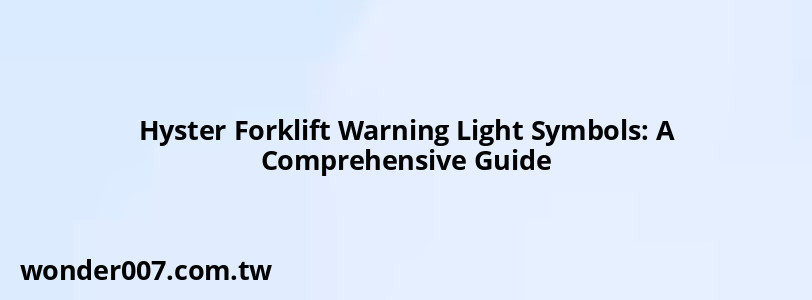Hyster Forklift Warning Light Symbols: A Comprehensive Guide

Understanding Hyster forklift warning light symbols is essential for operators and maintenance personnel to ensure safe and efficient operations. These symbols provide critical information about the forklift's operational status and potential hazards, helping to prevent accidents and equipment damage.
Overview of Hyster Forklift Warning Lights
Hyster forklifts are equipped with various warning lights that alert operators to specific conditions or malfunctions. Each light has a unique symbol and color, conveying vital information. Familiarity with these symbols is crucial for maintaining safety in any industrial environment.
Common Warning Light Symbols
Here are some of the most common warning light symbols found on Hyster forklifts:
- Red Exclamation Point: Indicates a potential safety hazard that requires immediate attention.
- Yellow Triangle with Exclamation Point: Signals caution; operators should be aware of their surroundings and proceed carefully.
- Green Arrow: Shows that the forklift is ready for operation.
- Blue Circle with "i": Provides information or instructions related to the forklift’s operation.
- Black Flag with "X": Indicates that the forklift cannot be driven, often due to a fault or safety issue.
Importance of Warning Lights
The warning lights on Hyster forklifts are designed to communicate essential information quickly. Ignoring these signals can lead to dangerous situations, including equipment damage or operator injury. Therefore, operators must be trained to recognize and respond appropriately to each warning light.
Frequently Encountered Issues
When a warning light activates, it typically points to specific issues that need addressing:
- Battery Discharge Indicator: This light indicates that the battery needs recharging or replacement. Operators should return the forklift to a charging station.
- Engine Temperature Warning Light: If this light illuminates, it means the engine is overheating. The operator should stop the forklift immediately and allow it to cool down.
- Oil Pressure Warning Light: This indicates low oil pressure, which can lead to engine damage if not addressed promptly.
FAQs About Hyster Forklift Warning Light Symbols
- What should I do if a warning light comes on?
Immediately check the operator manual for guidance on the specific symbol and take appropriate action. - Can I continue operating the forklift if a warning light is on?
No, you should not operate the forklift until the issue indicated by the warning light is resolved. - Where can I find more information about warning lights?
Refer to your Hyster forklift’s operating manual or consult your dealer for detailed information on warning lights and their meanings.
Understanding and responding to Hyster forklift warning light symbols is crucial for maintaining safety in any warehouse or industrial environment. Proper training and awareness can significantly reduce risks associated with forklift operation.
Related Posts
-
Cabin Air Filter for 2005 Ford Explorer: Essential Guide
29-01-2025 • 121 views -
Intake and Exhaust Valves on Chevy 350: Essential Guide
29-01-2025 • 180 views -
What Is A Triangle Warning Light On A Car
31-01-2025 • 161 views -
Drilling Holes for Rear License Plate: A Complete Guide
29-01-2025 • 160 views -
How To Bypass Overdrive Switch: A DIY Guide
26-01-2025 • 153 views
Latest Posts
-
How To Turn Off Paddle Shifters Mercedes
01-02-2025 • 335 views -
2015 Chevy Traverse AC Recharge Port Location
01-02-2025 • 366 views -
Rear Brake Caliper Piston Won't Compress
01-02-2025 • 315 views -
Power Steering Fluid Leak On Passenger Side
01-02-2025 • 420 views -
Are O2 Sensors Covered Under Warranty
01-02-2025 • 339 views
Popular Posts
-
Hino Warning Lights: Understanding Dashboard Alerts
26-01-2025 • 635 views -
V12 Engine Costs: What You Need to Know
26-01-2025 • 633 views -
Power Steering and ABS Light On: Causes and Solutions
27-01-2025 • 613 views -
EPC Warning Light: What It Means for Your Vehicle
27-01-2025 • 591 views -
EPC Light: Understanding Causes and Solutions
26-01-2025 • 1019 views
